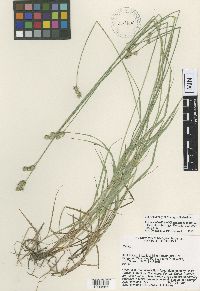Cyperaceae taxon details
Carex molestiformis Reznicek & Rothrock
1676293 (urn:lsid:marinespecies.org:taxname:1676293)
accepted
Species
terrestrial
Reznicek, A. A.; Rothrock, P. E. (1997). Carex molestiformis (Cyperaceae), a new species of section Ovales from the Ozark Mountain region. Contributions from the University of Michigan Herbarium, 21: 299-308., available online at https://www.biodiversitylibrary.org/page/12699698#page/305/mode/1up
page(s): 300 [details]
page(s): 300 [details]
Holotype MICH 1109135, geounit Oklahoma
Holotype MICH 1109135, geounit Oklahoma [details]
Description Plants cespitose; rhizomes appearing elongate only in old clumps. Culms 25–120 cm; vegetative culms few, inconspicuous,...
Taxonomic remark Source in seed data: wcs Updated scientificnameAuthorship from Reznicek & Rothrock to Reznicek & P.Rothr., information...
Description Plants cespitose; rhizomes appearing elongate only in old clumps. Culms 25–120 cm; vegetative culms few, inconspicuous, usually fewer than 15 leaves, not strikingly 3-ranked. Leaves: sheaths adaxially white-hyaline, summits U-shaped or truncate and reaching to 1.5 mm beyond collar, smooth; distal ligules 1.5–2.8 mm; blades 3–5 per fertile culm, 9–35 cm × 1.7–3.8 mm. Inflorescences congested or somewhat open, green to brown, 1.4–2.7(–3.4) cm × 7–16 mm; proximal internode 3–9 mm; 2d internode 3–8 mm; proximal bracts scalelike, bristle tips shorter than inflorescences. Spikes 2–5, distant, distinct, globose to ovoid, 10–35-flowered, 7–12 × 5–10 mm, base rounded or tapered, apex rounded; terminal spike usually lacking conspicuous staminate base. Pistillate scales yellowish brown, lance-ovate, 2.9–4 mm, 0.7–1.7 mm shorter than perigynium or reaching base or sometimes middle of perignyium beak, margins pale, apex acute or obtuse. Perigynia (10–)15–40(–45) per spike, ascending, light greenish brown to brown with pale margin, conspicuously 6-veined or more abaxially, 4–6-veined adaxially, broadly ovate to orbiculate, plano-convex, 4–5.4 × 2.4–3.4 mm, 0.5–0.6 mm thick, margin flat, including wing 0.3–0.8 mm wide, smooth; beak pale green or brown at tip, flat, 0.7–1.6(–1.8) mm, ciliate-serrulate, abaxial suture with white or hyaline golden brown margin, distance from beak tip to achene 1.7–2.6(–2.9) mm. Achenes broadly ovate to orbiculate, 1.6–2 × 1.4–1.8 mm, 0.5–0.6 mm thick. 2n = 74. [details]
Taxonomic remark Source in seed data: wcs Updated scientificnameAuthorship from Reznicek & Rothrock to Reznicek & P.Rothr., information...
Cyperaceae Working Group. (2025). [see How to cite]. Global Cyperaceae Database. Carex molestiformis Reznicek & Rothrock. Accessed at: https://cyperaceae.org/aphia.php?p=taxdetails&id=1676293 on 2025-09-13
Date
action
by
2024-12-10 11:47:54Z
unchecked
db_admin
![]() The webpage text is licensed under a Creative Commons
Attribution 4.0 License
The webpage text is licensed under a Creative Commons
Attribution 4.0 License
Nomenclature
original description
Reznicek, A. A.; Rothrock, P. E. (1997). Carex molestiformis (Cyperaceae), a new species of section Ovales from the Ozark Mountain region. Contributions from the University of Michigan Herbarium, 21: 299-308., available online at https://www.biodiversitylibrary.org/page/12699698#page/305/mode/1up
page(s): 300 [details]
basis of record Plants of the World Online (POWO). , available online at https://powo.science.kew.org/ [details]
page(s): 300 [details]
basis of record Plants of the World Online (POWO). , available online at https://powo.science.kew.org/ [details]
 Present
Present  Inaccurate
Inaccurate  Introduced: alien
Introduced: alien  Containing type locality
Containing type locality
From editor or global species database
Description Plants cespitose; rhizomes appearing elongate only in old clumps. Culms 25–120 cm; vegetative culms few, inconspicuous, usually fewer than 15 leaves, not strikingly 3-ranked. Leaves: sheaths adaxially white-hyaline, summits U-shaped or truncate and reaching to 1.5 mm beyond collar, smooth; distal ligules 1.5–2.8 mm; blades 3–5 per fertile culm, 9–35 cm × 1.7–3.8 mm. Inflorescences congested or somewhat open, green to brown, 1.4–2.7(–3.4) cm × 7–16 mm; proximal internode 3–9 mm; 2d internode 3–8 mm; proximal bracts scalelike, bristle tips shorter than inflorescences. Spikes 2–5, distant, distinct, globose to ovoid, 10–35-flowered, 7–12 × 5–10 mm, base rounded or tapered, apex rounded; terminal spike usually lacking conspicuous staminate base. Pistillate scales yellowish brown, lance-ovate, 2.9–4 mm, 0.7–1.7 mm shorter than perigynium or reaching base or sometimes middle of perignyium beak, margins pale, apex acute or obtuse. Perigynia (10–)15–40(–45) per spike, ascending, light greenish brown to brown with pale margin, conspicuously 6-veined or more abaxially, 4–6-veined adaxially, broadly ovate to orbiculate, plano-convex, 4–5.4 × 2.4–3.4 mm, 0.5–0.6 mm thick, margin flat, including wing 0.3–0.8 mm wide, smooth; beak pale green or brown at tip, flat, 0.7–1.6(–1.8) mm, ciliate-serrulate, abaxial suture with white or hyaline golden brown margin, distance from beak tip to achene 1.7–2.6(–2.9) mm. Achenes broadly ovate to orbiculate, 1.6–2 × 1.4–1.8 mm, 0.5–0.6 mm thick. 2n = 74. [details]Taxonomic remark Source in seed data: wcs Updated scientificnameAuthorship from Reznicek & Rothrock to Reznicek & P.Rothr., information provided by Alan E. on email Oct. 12 2020 More details could be found in [details]
To Biodiversity Heritage Library (6 publications)
To European Nucleotide Archive, ENA (Carex molestiformis)
To Field Museum Herbarium (Carex molestiformis Reznicek & P. Rothr. F2179798 isotype 1)
To GenBank (10 nucleotides; 1 proteins)
To International Plant Names Index (IPNI)
To Plants of the World Online
To Royal Botanic Gardens, Kew (Carex molestiformis K001079153 isotype 1)
To University of Minnesota Herbarium (Carex molestiformis MIN514864 isotype 1)
To US Herbarium (Carex molestiformis US3351329 type 1)
To European Nucleotide Archive, ENA (Carex molestiformis)
To Field Museum Herbarium (Carex molestiformis Reznicek & P. Rothr. F2179798 isotype 1)
To GenBank (10 nucleotides; 1 proteins)
To International Plant Names Index (IPNI)
To Plants of the World Online
To Royal Botanic Gardens, Kew (Carex molestiformis K001079153 isotype 1)
To University of Minnesota Herbarium (Carex molestiformis MIN514864 isotype 1)
To US Herbarium (Carex molestiformis US3351329 type 1)







